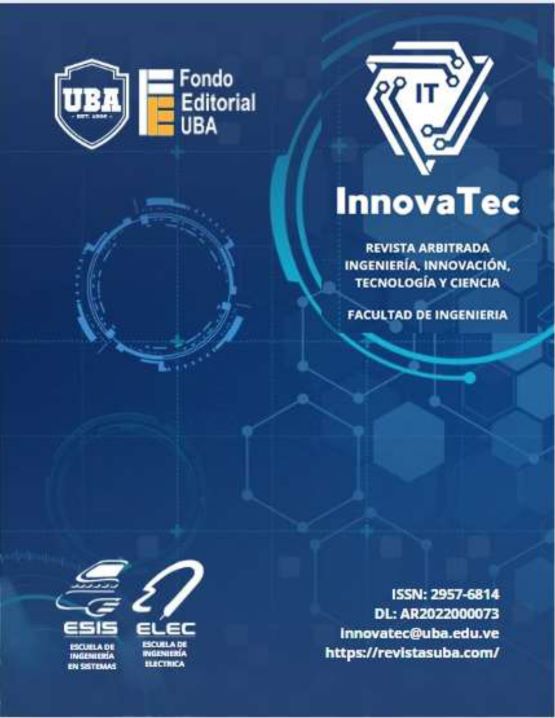HERRAMIENTAS DE APRENDIZAJE CON INTELIGENCIA ARTIFICIAL: INNOVACIÓN EN ENTORNOS VIERTUALES DE APRENDIZAJE Artificial Intelligence Learning Tools: Innovation in Virtual Learning Environments.
Contenido principal del artículo
Resumen
En este artículo se explora la implementación de la integración de la inteligencia artificial
(IA) en los Entornos Virtuales de Aprendizaje (EVA). La educación virtual ha
experimentado un crecimiento significativo en los últimos años, y la IA está
revolucionando esta área al ofrecer herramientas innovadoras que mejoran la calidad y
la accesibilidad del aprendizaje. En la revisión teórica, se definen y caracterizan los EVA,
destacando su naturaleza digital y su capacidad para facilitar la interacción didáctica sin
restricciones de espacio y tiempo. Además, se analizan algunas herramientas con IA
que pueden ser utilizadas para personalizar el aprendizaje y mejorar la eficiencia del
proceso educativo. En el plano metodológico, se resume el procedimiento seguido para
la generación e implementación de dos herramientas de aprendizaje con IA, destacando
los resultados positivos obtenidos. Finalmente, se concluye en la necesidad de
colaboración continua entre educadores, desarrolladores de tecnología y políticas
educativas para maximizar el potencial de estas herramientas. La integración efectiva de
estos materiales puede conducir a una educación más inclusiva, personalizada y de alta
calidad, preparando a los estudiantes para un futuro cada vez más digital y conectado.
Abstract
This article explores the implementation of artificial intelligence (AI) integration in Virtual
Learning Environments (V LE). Virtual education has experienced significant growth in
recent years, and AI is revolutionizing this area by offering innovative tools that improve
the quality and accessibility of learning. In the theoretical review, VLEs are defined and
characterized, highlighting their digital nature and their ability to facilitate didactic
interaction without space and time restrictions. In addition, some AI tools that can be used
to personalize learning and improve the efficiency of the educational process are
analyzed. At the methodological level, the procedure followed for the generation and
implementation of two AI learning tools is summarized, highlighting the positive results
obtained. Finally, it is concluded that there is a need for continued collaboration between
educators, technology developers and educational policies to maximize the potential of
these tools. The effective integration of these materials can lead to a more inclusive,
personalized and high-quality education, preparing students for an increasingly digital
and connected future.
Keywords: didactic interactions, personalized learning, virtual education.
Detalles del artículo
Citas
Aparicio, W. (2023). La inteligencia artificial y su incidencia en la educación: transformando el aprendizaje para el siglo XXI. Revista Internacional de Padagogía e Innovacion Educativa, 3(2). Disponible en: https://editic.net/ripie/index.php/ripie/article/view/133/114, consultado: 2024, junio 08.
Aula1. (s.f.). Qué es un Entorno Virtual de Aprendizaje (EVA). Disponible en: https://www.aula1.com/entorno-virtual-aprendizaje-eva/, consultado: 2024, julio 08.
Bard. (2023). Recuperada el 15 de noviembre de 2023, de: https://bard.google.com/chat/
Belloch, C. (s.f.). Entornos Virtuales de Aprendizaje. Unidad de Tecnología Educativa (UTE). Universidad de Valencia. Disponible en: https://www.uv.es/bellochc/pedagogia/EVA3.pdf, consultado: 2024, julio 04.
González, C. (2023). El impacto de la inteligencia artificial en la educación: transformación de la forma de enseñar y de aprender. Revista Qurriculum, 36, 51-60. Disponible en: https://doi.org/10.25145/j.qurricul.2023.36.03, consultado: 2024, junio 01.
González, J., y Granera, J. (2021). Entornos Virtuales de Aprendizaje (EVA) para la enseñanza-aprendizaje de la Matemática. Revista Científica de FAREM-Estelí. Disponible en: https://rcientificaesteli.unan.edu.ni/, consultado: 2024, julio 10.
González, M., y Romero, R. (2022). Inteligencia artificial en educación: de usuarios pasivos a creadores críticos. Escenas. Disponible en: https://doi.org/10.22201/fesa.26832917e.2022.4.1.243, consultado: 2024, julio 12.
Ludus Global. (s.f.). Entornos Virtuales de Aprendizaje (EVA): Características y Ejemplos. Disponible en: https://www.ludusglobal.com/blog/entornos-virtuales-de-aprendizaje-eva-caracteristicas-y-ejemplos, consultado: 2024, julio 10.
Monroy, E. (2019). Estrategias Educativas en Ambientes Digitales. Entornos Virtuales de Aprendizaje. Disponible en: https://estrategiaseducativasenambientesdigitales.school.blog/2019/11/03/caracteristicas-de-los-eva/, consultado: 2024, julio 05.
Sandoval, E. (2018). Aprendizaje e inteligencia artificial en la era digital: implicancias socio-pedagógicas ¿reales o futuras? Revista Boletín Redipe, 7(11), 155-171. Disponible en: https://revista.redipe.org/index.php/1/article/view/626/583, consultado: 2024, junio 20.
Segura, A., y Gallardo, M. (2013). Entornos virtuales de aprendizaje: nuevos retos educativos. Revista Eticanet. Disponible en: chrome-extension://efaidnbmnnnibpcajpcglclefindmkaj/https://www.ugr.es/~sevimeco/revistaeticanet/numero132/Articulos/Formato/177.pdf, consultado: 2024, julio 08.
Vera, F. (2023). Integración de la Inteligencia Artificial en la educación superior: Desafíos y oportunidades. Transformar, 4(1), 17-34. Disponible en: https://www.revistatransformar.cl/index.php/transformar/article/view/84/44, consultado: 2024, junio 15.
